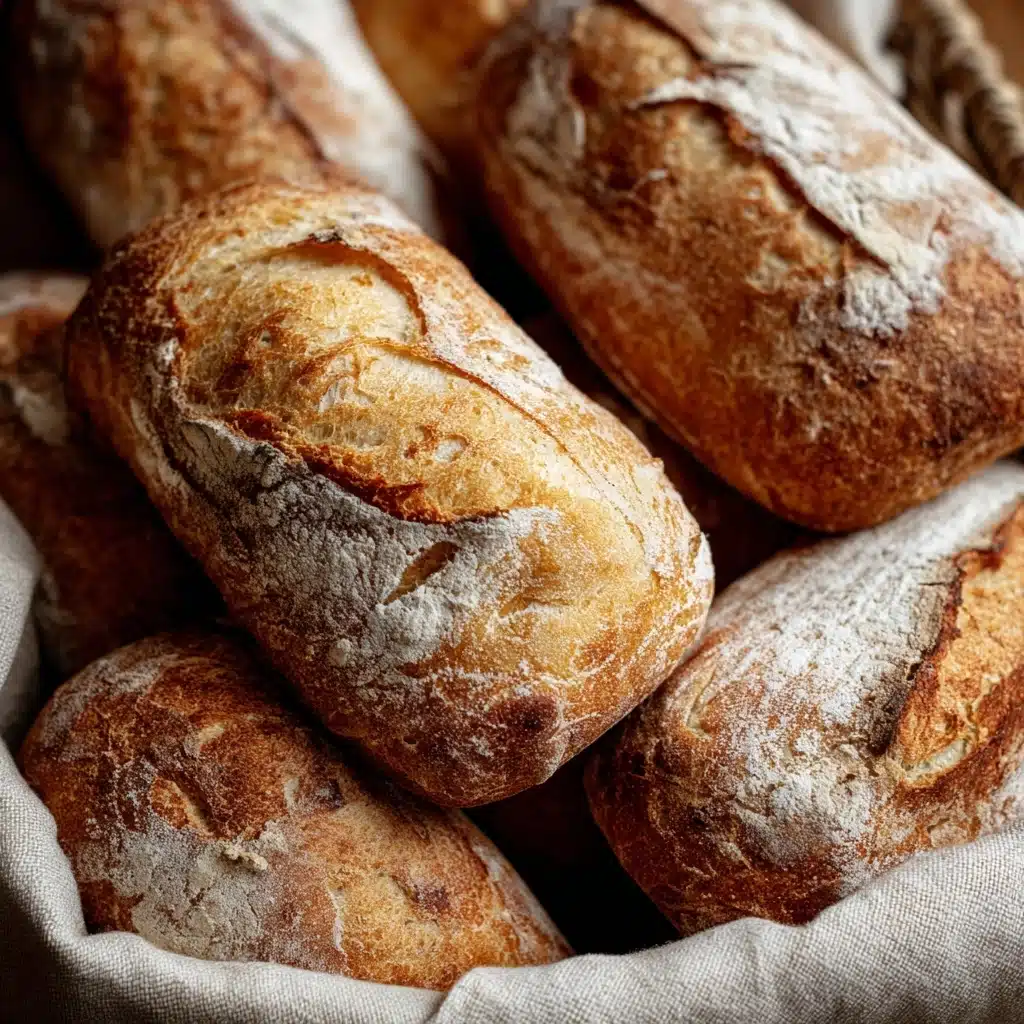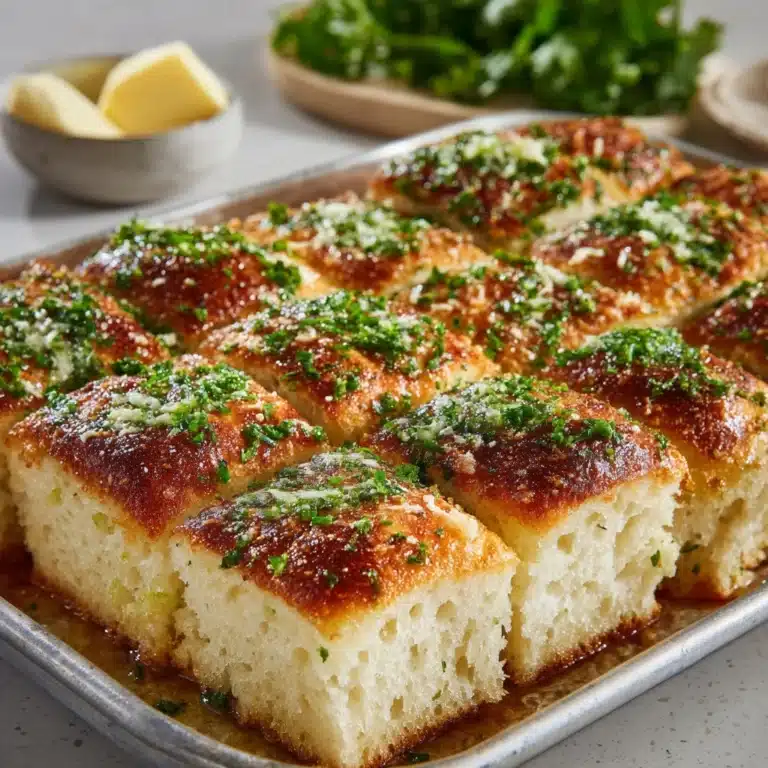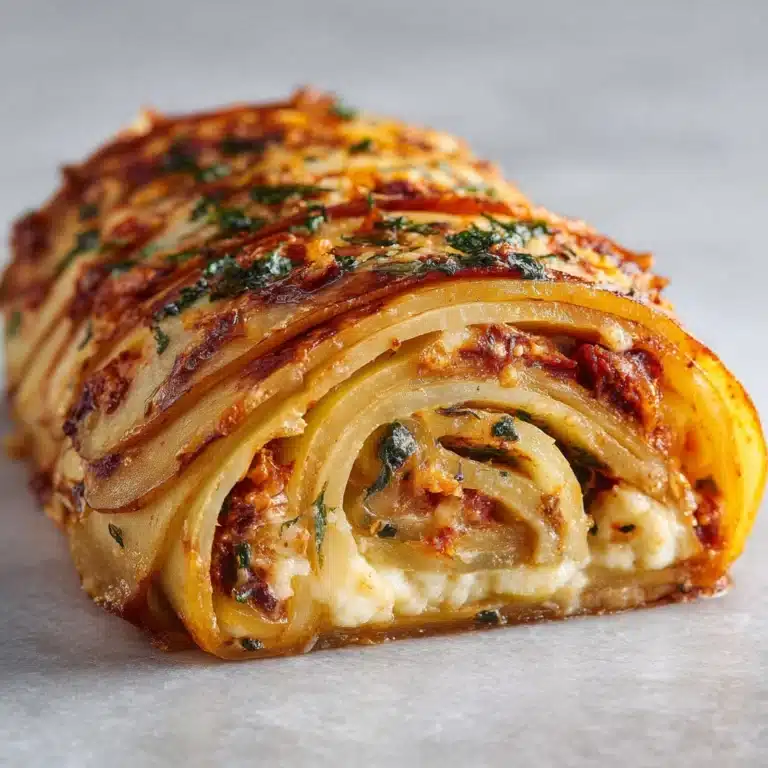If you’re searching for crusty, chewy, artisan-style bread made right in your own kitchen, homemade ciabatta bread is the answer. This Italian classic is famous for its airy crumb, signature open holes, and slightly tangy flavor—plus, it looks like it just came from a cozy downtown bakery. There’s something magical about how simple ingredients transform overnight into textured, golden perfection, and honestly, watching the dough bubble and rise is half the fun. Whether you slather it with olive oil or layer it with prosciutto, this homemade ciabatta bread is bound to become a staple in your home.
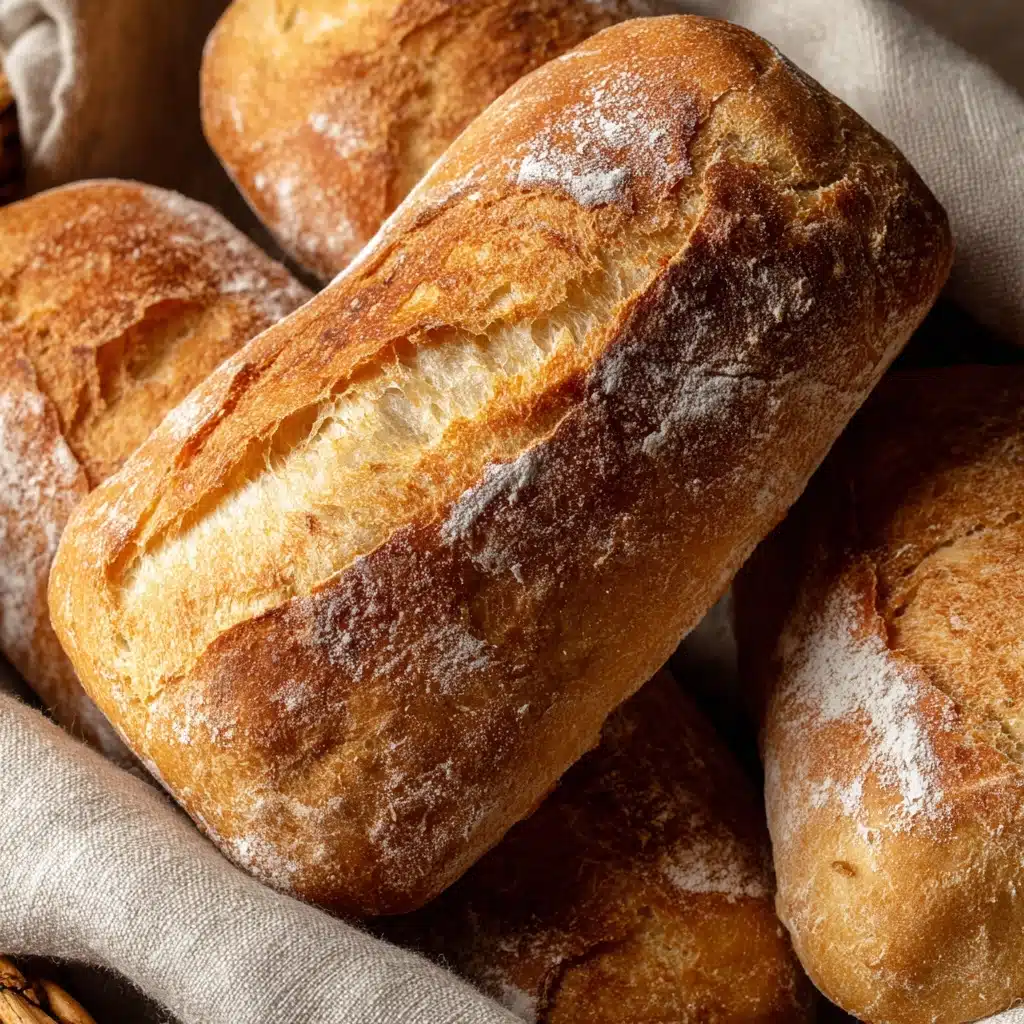
Ingredients You’ll Need
The beauty of homemade ciabatta bread is in its simplicity—just a handful of pantry staples, each playing a crucial role in creating that airy, unforgettable loaf. Every ingredient impacts the structure, flavor, and rustic character that make ciabatta so irresistible.
- Bread flour: High-protein bread flour gives homemade ciabatta bread its elastic gluten structure, which creates those distinctive big holes and a chewy bite.
- Salt: Don’t skimp on salt—it enhances flavor and helps control the fermentation, making your bread aromatic and well-balanced.
- Instant yeast: Instant yeast ensures a good, steady rise, so you get perfectly aerated dough without the need for a preferment or sponge.
- Lukewarm water: Warm (not hot!) water activates the yeast and keeps the dough super hydrated, providing that classic ciabatta open crumb.
- Olive oil (for greasing): Just a bit for greasing keeps the dough from sticking, and adds a subtle whisper of richness to the crust.
How to Make Homemade Ciabatta Bread
Step 1: Mixing the Dough
Grab your largest mixing bowl—it’s time to bring together bread flour, salt, and instant yeast. Give them a quick whisk to evenly distribute everything, then pour in the lukewarm water. Using a wooden spoon or sturdy spatula, stir until you have a rough, shaggy, and very sticky dough. Don’t be tempted to add more flour! The high hydration is key to that classic homemade ciabatta bread texture.
Step 2: The Long, Slow Rise
Cover your bowl tightly with plastic wrap and set it aside at room temperature. The magic happens now: over 12–18 hours, your dough will bubble, double in size, and become wonderfully elastic. Take a peek to see dramatic changes—fermentation brings out deep, complex flavors and those big airy pockets.
Step 3: Shaping the Loaves
Once the dough is airy and risen, dust your work surface generously with flour and gently turn the dough out. Sprinkle more flour over the top and, with floured hands, handle the dough tenderly to avoid deflating too much of that beautiful air. Shape into a loose rectangle, then slice into two equal pieces. Gently stretch each piece into a loaf-like shape, taking care to preserve the open crumb structure.
Step 4: Second Rise and Oven Prep
Transfer your shaped loaves onto a parchment-lined baking sheet, leaving enough space for them to expand. Drape with a clean kitchen towel and let the loaves rest and rise for about 30 minutes while you preheat your oven to 425°F (220°C). If you’re after an extra-crackly crust, position a pan of water on the lower rack to fill the oven with steam as the bread bakes.
Step 5: Baking to Perfection
It’s time for homemade ciabatta bread to shine! Slide the tray into the hot oven and bake for 20-25 minutes, until the loaves are deep golden brown and the bottoms sound hollow when given a gentle tap. The aroma will be absolutely irresistible. Once baked, move the loaves to a wire rack and let them cool completely so the crumb sets—slice too early and you’ll lose all that work!
How to Serve Homemade Ciabatta Bread
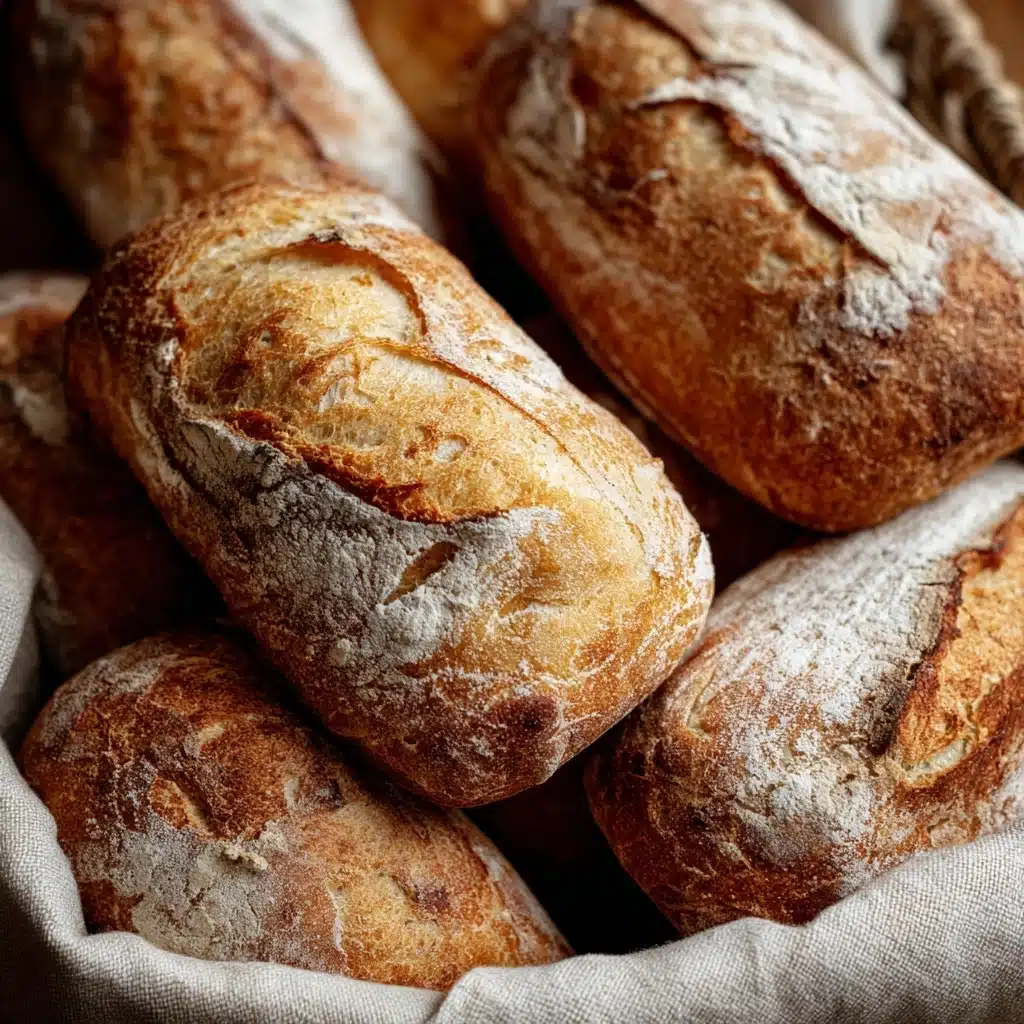
Garnishes
While homemade ciabatta bread is incredible all on its own, a sprinkle of flaky sea salt, freshly chopped rosemary, or a drizzle of quality olive oil on warm slices takes it up a notch. You can even add roasted garlic or sun-dried tomatoes for a hint of Mediterranean flair.
Side Dishes
Crisp ciabatta slices are the perfect partner for Italian antipasti, vibrant salads, or hearty stews. Pair alongside creamy tomato soup, savory dips, or platter-style dinners—this bread knows no limits when it comes to accompaniments.
Creative Ways to Present
Impress your guests by serving homemade ciabatta bread as mini appetizer sandwiches, rustic crostini, or even as the base for an open-faced tartine. For parties, cube it and serve with infused olive oils and balsamic vinegar for dipping—absolutely irresistible!
Make Ahead and Storage
Storing Leftovers
If you have any leftovers (though it’s honestly hard to resist eating it all fresh!), wrap your homemade ciabatta bread tightly in a paper bag or bread box at room temperature. It stays soft for up to 2 days, but if you prefer a crispier crust, pop slices in the toaster just before eating.
Freezing
Homemade ciabatta bread freezes beautifully. Let the loaves cool completely, then wrap tightly in plastic wrap and foil. Pop the bread in the freezer for up to three months. When you’re ready for more, thaw at room temperature, then refresh in a warm oven for five minutes.
Reheating
For that just-baked flavor, reheat slices or whole loaves in a 350°F oven for about 5–10 minutes. If reheating frozen ciabatta, let it thaw first, then lightly mist with water before warming to revive the crisp crust and soft crumb.
FAQs
Can I use all-purpose flour instead of bread flour?
While bread flour gives homemade ciabatta bread its chewy texture and signature holes, you can swap in all-purpose flour if that’s what you have. Just know your loaf may be slightly more dense and less airy, but still delicious!
How do I know when my dough has proofed enough?
The dough should look incredibly bubbly and at least doubled in size after 12–18 hours. If it jiggles like a marshmallow and small bubbles are visible throughout, it’s ready for shaping.
Why is my ciabatta crust not as crisp as bakery versions?
Achieving a crisp crust is all about steam! Placing a pan of water in your oven during baking helps mimic a professional steam oven, resulting in a delightfully crackly exterior.
Can I add herbs or olives to this recipe?
Absolutely! Fold in chopped rosemary, thyme, or pitted olives right before the first rise for a flavorful twist that still celebrates the essence of homemade ciabatta bread.
How do I avoid deflating the dough when shaping?
Use a light touch and plenty of flour on your hands and work surface. Handle the dough gently—never knead or punch it down—to keep those gorgeous air pockets intact.
Final Thoughts
There is nothing quite like the pride and aroma that fills your kitchen when you bake homemade ciabatta bread from scratch. The process is as rewarding as it is simple, and your sandwiches, snacks, and dinners will thank you for it. The next time you crave bakery-quality bread, let this recipe be your go-to—slice, share, and enjoy every last crumb!
Print
Homemade Ciabatta Bread Recipe
- Total Time: 13 hours
- Yield: 2 loaves 1x
- Diet: Vegan
Description
Learn how to make delicious Homemade Ciabatta Bread with this easy recipe. This artisan bread requires minimal effort but yields a crusty exterior and a soft, chewy interior that’s perfect for sandwiches or dipping in olive oil.
Ingredients
Dough:
- 4 cups bread flour
- 1 1/2 teaspoons salt
- 1 teaspoon instant yeast
- 2 cups lukewarm water
Additional:
- 1 tablespoon olive oil (for greasing)
Instructions
- Mix Dry Ingredients: In a large bowl, combine bread flour, salt, and instant yeast. Add lukewarm water and mix until a wet, sticky dough forms.
- Rise: Cover the bowl and let the dough rise at room temperature for 12-18 hours until doubled in size.
- Shape: Turn out the dough onto a floured surface, divide into loaves, shape, and let rest.
- Bake: Preheat oven, bake loaves until golden brown and hollow-sounding.
- Cool: Transfer to a wire rack to cool before slicing.
Notes
- For a better crust, create steam in the oven by placing a pan of water inside while baking.
- Best served fresh but can be frozen for later consumption.
- Prep Time: 15 minutes (plus 12-18 hours rising time)
- Cook Time: 25 minutes
- Category: Bread
- Method: Baking
- Cuisine: Italian
Nutrition
- Serving Size: 1 slice
- Calories: 120
- Sugar: 0g
- Sodium: 180mg
- Fat: 1g
- Saturated Fat: 0g
- Unsaturated Fat: 1g
- Trans Fat: 0g
- Carbohydrates: 24g
- Fiber: 1g
- Protein: 4g
- Cholesterol: 0mg
